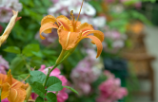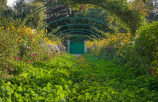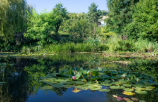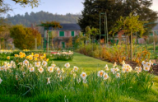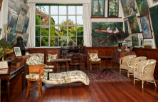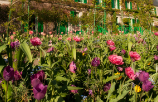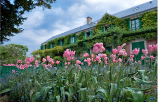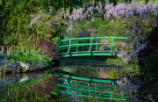Quotes
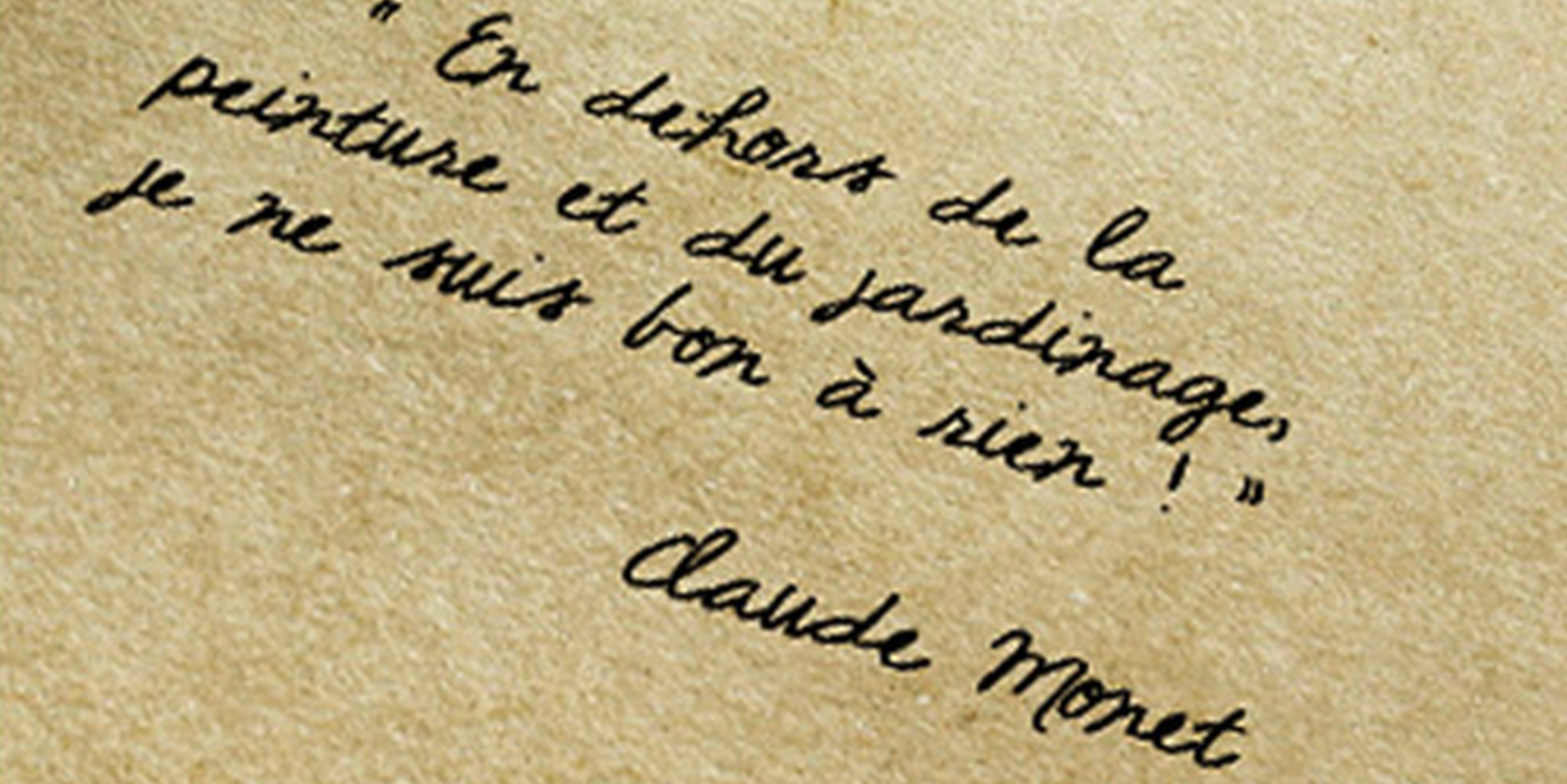
“I am in raptures. Giverny is a wonderful place for me.”
Monet to Duret
“How I dream of Giverny in this lovely weather and envy you for being there, you have no idea. But I am a prisoner and must see it through, despite being completely drained. It’s exhausting and I’m working with feverish ardour.”
Monet to Alice
“I’m still awaiting your promised visit. Now is the time to come, you’ll see a stunning garden, but you must hurry […]. Later, all the plants will lose their flowers. Discuss it with Geffroy and write to me. I’m counting on you. And I have a heap of new paintings. Your friend. Give Geffroy a hurry up and come visit.”
Monet to Clemenceau
“Ah, gentlemen, I do not receive guests when I’m working, indeed. When I work, if I am interrupted, I lose all inspiration; I am lost. You understand, I’m chasing a band of colour.”
Monet to Georges Bernheim and René Gimpel
“The weather is definitely cooler and you should tell Eugène to cover the tigridias and the others he knows about; especially with this moon, he thought there could be a frost. Tell him also, if there are any sudden downpours or hail storms (we had one here yesterday), to pull down the greenhouse covers.”
Monet to Alice
“My dear friend, ensure you come on Monday as agreed. All my irises are flowering but later some will fade. Here is the name of the Japanese plant that was sent to me from Belgium: Crythrochaete. See Mr Godefroy about it and try to get me some information on how to grow it.”
Monet to Caillebotte
“Let me take this opportunity to give you the address of the rose nursery […] as well as the names of the roses you noticed […]: the climbing rose in front of the house is the Crimson Rambler and the tree one is the Virago.”
Monet to the Bernheim-Jeunes
“We all got to work in the garden. I dug over the soil, planted and weeded, and in the evenings the children watered the garden. When that area started to look better, I moved onto the next section.”
Monet
“And the garden? Are there still flowers? I would love for the chrysanthemums to still be flowering when I return. If the frosts arrive, make them into beautiful bouquets.”
Monet to Alice
“While you philosophically seek the world in and of itself, I simply focus my efforts on a maximum number of appearances, in close correlation with unknown realities.”
Monet
“I want to paint the air in which the bridge, house or boat exists. The beauty of the air where they are. Yet it is nothing short of impossible.”
Monet
“It took me a while to understand my water lilies… I grew them without thinking about painting them… A landscape does not pervade your senses in one day… Then suddenly I had a revelation and clearly saw these wonders on my pond. I took up my palette and paintbrush. And since then, I’ve hardly used any other subject.”
Monet
“You can imagine what I’m becoming. It is hard for me to work as my eyesight diminishes every day, so I spend a lot of time gardening. My garden is my joy and, in the lovely weather we have had, I exult in and admire nature. With all that, there’s no time to get bored.”
Monet to Gaston Bernheim-Jeune
“The motif is secondary; what I want to capture is what there is between the motif and myself.”
Monet
“It’s a trade I learned as a youth… when I was unhappy… Perhaps flowers are the reason why I am an artist.”
Monet
“Thank you for thinking of me for the Hokusai flowers […]. You do not mention the red poppies, which are the important ones as I already have irises, chrysanthemums, peonies and morning glories.”
Monet in a letter to Maurice Joyant, Giverny, 8 February 1896
“I was flattered by your two letters, as I have the deepest admiration for Japanese art and a great liking for the Japanese people […]. It is with the greatest pleasure that I received your pretty prints.”
Monet in a letter to Shintarō Yamashita, Giverny, 19 February 1920
“You had to see Monet in Giverny to know him and understand his character, thirst for life, and private nature. […] This house and this garden, they are also artworks and Monet spent his life creating and perfecting them.”
Gustave Geffroy.
“This home is modest yet sumptuous in the layout of its interior and the garden – or rather gardens – that surround it. The person who designed and laid out this magnificent little domestic world is a great artist not only when creating paintings but also when creating an enjoyable setting for his life.”
Gustave Geffroy
“This studio/lounge was full of life and youth in 1886 when I visited for the first time: young girls, young folk, teenagers, Madame Monet’s children and step-children. […]. After eating, we returned to the studio to drink coffee, walking through the blue lounge which holds Monet’s library. That is when Madame Monet appeared, surrounded by her children and Monet’s children, brimming with contentment in her happy life, her eyes shining brightly under her halo of powdered hair.”
Gustave Geffroy
“It is essential to make a pilgrimage to Giverny, to this floral sanctuary, to better understand the artist and his sources of inspiration, and imagine him still living amongst us.”
Gérald Van der Kemp
“If I said that Claude Monet was born in Paris, on rue Laffitte, meaning in the art dealer district – a sign of his destiny perhaps – it might not have helped our business. But if I added that he spent his entire youth in Le Havre, where he fell in love with the light that the turbulent coastal ocean reflected from the endless space, that might explain his familiarity with, and eye for, the acrobatic light of a crazy atmosphere chucking all sorts of colours and shades around to be squandered by the waves and wind.”
Clemenceau
“Of average size, with the poise of a robust, well-built frame, an aggressively smiling gaze and a firm, resounding voice; is that not enough to say ‘a healthy mind and a healthy body,’ an upright character with strong willpower?”
Clemenceau
“Monet’s garden is one of his artworks, achieving the charm of nature adapted to the artist’s work and the light. Like an outdoor extension of the studio, with colour palettes profusely scattered all around making one’s eye perform acrobatics, with a thirst for shimmering colours from which a feverish retina awaits unquenchable joys […]. You do not need to know how he made his garden. It is clear that he created it as his eye commanded, as each day required, to satisfy his thirst for colour.”
Clemenceau
“Sometimes I sat on the bench seat from which Monet’s gaze had seen so many things in his water garden’s reflections. My inexperienced eye had to persevere to distantly track the master’s paintbrush all the way to the ends of its revelations.”
Clemenceau
“Like everyone else, I had already noticed that from where Monet had to stand to paint, the viewer would only see a storm of crazily mixed colours on the canvas. But take a few steps back and on the same canvas you’ll see nature taking shape and miraculously becoming clear in the impossibly jumbled multicoloured spots that were confusing at first glance. […] How did Monet, who did not move, manage to capture that same perspective while breaking down and reconstructing the colours that enabled the desired effect to be achieved?”
Clemenceau
“In his washroom, hung on the wall, was ‘The Negro Scipion’ in blue trousers by Cézanne; ‘18 year old Monet’ by Gilbert Alexandre de Séverac and, in a corner, a small painting depicting Monet in a Chasseur d’Afrique uniform; a watercolour by Boudin; ‘The Rain’ by Caillebotte; and several other paintings and small pastel landscapes by Monet. In his bedroom, all the walls were covered with paintings. I counted eleven Cézannes and four Manets!
By Renoir: two portraits of Claude and Madame Monet, ‘Madame Monet reading Le Figaro’, an Algerian woman, the Kasbah, and two nude studies. One Degas, some Jongkinds, a Corot, portraits of Monet by Sargent – one painting on his studio-boat and the other wearing a Basque beret with the Monaco Coast painting as a backdrop. And more that I’ve forgotten (I only took notes when Monet wasn’t looking!). However, I noticed there was no Gauguin or Van Gogh.”
Paulette Howard-Johnston
“… the room is sunny, the walls papered in lemon yellow are only decorated with the Japanese prints that Monet told us he had bought in stacks for a few francs in Holland. He showed us to our seats […] He poured us a drink and watched us serve ourselves the dishes. ‘But you are not eating.’ It was clear that Monet was awaiting our compliments, which we duly showered him with.”
Jacques Salomon
“In terms of lunches, Claude Monet’s is wonderful. First a few hors-d’oeuvres with the best Normandy butter, succulent sweetbreads with spinach, two chickens, and all for five people; the first is burnt and nobody touches it; the second is extraordinary, with black olives. This is followed by a wonderfully sweet tart and fruit as beautiful as flowers. Monet always loved being at the table.”
René Gimpel
“If I could one day see Claude Monet’s garden, I feel that, in that garden of colours and hues more so than of flowers, I would see a garden that is less a traditional florist’s garden and more a colourist’s garden, if you can say that, with flowers laid out in an arrangement that is not entirely natural because they have been planted so that only those whose colours match should bloom at the same time, creating expanses of blue or pink, and so that the artist’s powerfully manifested intention has, in a way, dematerialised everything but colour.”
Marcel Proust
“In a bare pasture, without a single tree, but watered by a branch of the Epte with its chattering, sinuous flow, he created a genuinely magical garden, digging a wide pond in the middle, planting exotic trees and weeping willows around the edge with their branches drooping on the banks, creating pictures all around the valley including arches of greenery, crossing and returning to meet themselves, giving the illusion of a vast park, sprinkling the pond with a profusion of thousands of water lilies whose carefully selected, rare species burst with colour in every possible hue, from purple, red and orange to pink, lilac and mauve, and planting over the Epte, where the pond flows away, one of those little rustic bridges, a humpback bridge like you see in gouache paintings from the 18th century and on Toile de Jouy fabrics.”
Thiébault-Sisson
“The pond fed by the Epte is framed by Babylon willows with golden branches. The pond’s edge and backdrop are decorated with a mass of ericaceous soil plants, ferns, kalmias, rhododendrons, azaleas and holly. The water’s edge is shaded on one side by roses with lush foliage and the pond itself is planted with all known varieties of water lilies […]. A substantial stand of bamboo forms a dense forest. Also on the water’s edge are petasites with huge leaves; on the lawns are thalictrums with jagged leaves, some ferns with light, cottony pink or white flowers, wisteria, etc. There are still some tamarix and the garden is sprinkled with rose trees and rose shrubs.”
Georges Truffaut
“The garden’s overall style, particularly the little green bridge, has given it the local nickname of ‘the Japanese garden’. Mr Hayashi, Japanese commissioner at the 1900 exhibition, was also struck by this resemblance which Monet denied having planned. However, he had a deep love of Japan.”
Maurice Kahn
“I often painted these water lilies, each time changing my viewpoint, updating the motif throughout the year depending on the season and, subsequently, tracking the differences in lighting effects caused by those changes. In fact, those effects are constantly changing. The core of the motif is the watery mirror which constantly changes its appearance thanks to the sections of sky reflected in it, scattering life and movement. The passing cloud, the cooling breeze, the abrupt squall, the wind that gently blows then suddenly strikes, the light that dims and returns; so many sources imperceptible to the untrained eye and that disfigure the water’s surface and transform its colour.”
Monet to Thiébault-Sisson
“Monsieur Monet, whose eye
Neither winter nor summer deceives,
As a painter in Giverny lives
Near Vernon, on the River Eure.”
Stéphane Mallarmé
“You must see it in summer, that famous garden that was his luxury and his glory, and for which he acted as foolishly as a king for his mistress…”
Louis Gillet



